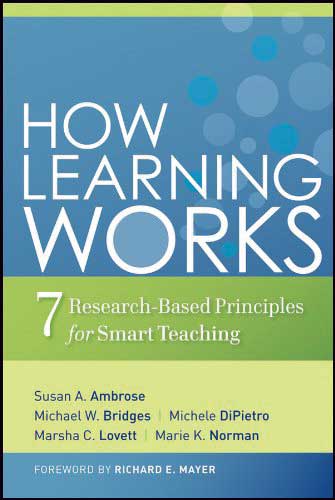Aruna Sankaranarayanan
Teachers, across subjects, grades, and curricula, hope to impart meaningful, memorable, and motivating lessons. Whether we’re discussing ancient civilizations, Euclidean geometry, or the volatility of stock markets, we would like students to be engrossed and enthused both during and after our classes. Rather than viewing students as passive receptacles, learning is effective only if learners engage actively with concepts and skills. Are there general learning principles that teachers, spanning different domains, age groups and cultures, can wield to make learning more efficient and robust?
Yes, indeed. In How Learning Works: 7 Research-Based Principles for Smart Teaching, Susan Ambrose, Michael Bridges, Michele DiPietro, Marsha Lovett, and Marie Norman outline a set of principles that do just that. Though the book is written with college professors in mind, the learning principles, that include both cognitive and affective factors, are just as relevant for school teachers.
Most teachers recognize the significance of prior knowledge that students bring to a learning situation and how that impacts further knowledge. Prior knowledge that is accurate, activated, and apt can aid subsequent learning, whereas inaccurate, incomplete, or inert constructs learnt earlier may interfere with learning. Thus, teachers may both assess and activate students’ prior knowledge by asking students to brainstorm or create concept maps before introducing new themes.

Next, the way students organize knowledge impacts what they remember and apply. The authors believe that teachers may influence students’ knowledge organization by providing pupils with tasks that allow them to form meaningful linkages between relevant concepts, with nodal points connected coherently. Initially, teachers may create concept maps of their own to see how various constructs tie into each other and then help students identify organizational features to structure their learning more optimally. By understanding how new information fits into a conceptual space, students “recognize meaningful patterns” and are more likely to access and apply it in novel situations.
Another fundamental factor, and possibly the most important, that drives students’ learning is their level of motivation. At all stages of the learning process, motivation determines how much effort students are willing to exercise. Students need clearly articulated learning goals that seem valuable to them. Further, they also need to believe that they have the ability to meet the learning outcomes set for them. Thus, teachers may create an array of activities that cater to the various skill and competency levels within a classroom. All students need to feel that they are capable of meeting task demands. When students are in a learning environment that they feel is supportive and have a high sense of efficacy in their capabilities to achieve goals they deem valuable, healthy motivation is bound to result.
As teachers often impart complex skills and concepts, good teaching involves decomposing complex competencies and constructs into smaller, more manageable units. Besides giving students sufficient practice in mastering component skills, teachers also need to help students integrate the various pieces together and learn to apply their knowledge in a variety of contexts. To help students attain mastery, teachers may provide activities. A meaningful education should equip students to exhibit far-transfer, wherein they are able to apply what they have learned in classrooms to unfamiliar situations. As far-transfer doesn’t necessarily occur automatically, teachers need to emphasize deep principles, underlying structures and help students identify a range of contexts where transfer might be applicable.
An essential facet of teaching is to provide students with “goal-directed practice” and targeted feedback. The adage “Practice makes perfect” isn’t necessarily true unless students identify specific, actionable learning goals and perform related activities that offer an optimal level of challenge. Giving pupils targeted and personalized feedback on whether they are meeting certain criteria can both motivate and help them hone their skills to get to the next level. The right kind of feedback at the right time can be a great impetus to learning.
Excellent teaching also entails being aware of and responding to the diverse needs of individual learners. Teachers may create a classroom climate that respects the multitude of learner profiles that make up a class. Children bring a panoply of differences to the learning situation that span physical, cognitive, linguistic, social, emotional, religious, and cultural factors. As teachers, we need to examine, and perhaps, question our own assumptions and biases. To create a classroom that is mindful and respectful of all kinds of differences, we may engage in a number of practices.
Foremost, we must foster a climate that welcomes multiple viewpoints where all students feel safe to voice their opinions. We also need to create ground rules, preferably along with students, so that peer interactions are also “inclusive and respectful.” Getting to know students individually can go a long way in building rapport with the whole class. Asking students for feedback on various aspects of our teaching and incorporating their suggestions into your teaching models an open mind.
Ultimately, the litmus test of a good education is whether we create self-directed learners. To facilitate this process, teachers may help students build metacognitive awareness that allows pupils to assess task demands and their own capabilities. Students may also learn to chalk out goals, gauge their progress and make adjustments to their approach. Importantly, teachers may model and impart a growth mindset to students, wherein they believe that their skills and knowledge, in any domain, may improve with the right kinds of practice. How Learning Works is a wonderful book that offers an arsenal of techniques for teachers to be more effective and engaging while enhancing deep learning. It’s up to you to embrace them to create magic in the classroom and beyond.
The writer is the author of Zero Limits: Things Every 20-Something Should Know. She blogs at www.arunasankaranarayanan.com.
